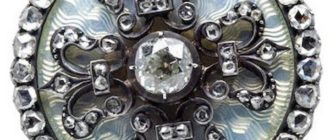
The St. Petersburg firm “Bolin” under the leadership of Karl Eduard Bolin, which became one of the largest jewelry firms in Russia in the 19th century, made precious jewelry and gifts for the royal family and courtiers. The Moscow branch of the company was founded by Henrik Konrad Bolin, brother of Karl Eduard. In contrast to the tastes of aristocratic St. Petersburg, the Moscow public preferred a more traditional Russian style with patterns and forms characteristic of Russian aesthetics.

There was a long tradition of jewelry making in Moscow, and the best silversmiths of Russia lived in Moscow. Understanding the peculiarities of the Moscow market, Henrik Konrad Bolin decided to invest in silver, adding expensive and elegant accessories for women: handbags, wallets, fans, gloves, feathers, hair ornaments, lace and fur details. The spacious and luxurious store also had a selection of exclusive jewelry and jewelry from Bolin from St. Petersburg.
In 1852, together with the Englishman James Stuart Shanks, Henrik Bolin founded the English Store. Shanks and Bolin. Very quickly, the business took off and began to expand. Shanks & Bolin focused on a wider range of consumers than the Bolin company in the capital, specializing in products with crystal in silver frames, silver vases and bowls. At the turn of the century, the company mastered the production of products in the Art Nouveau style, while the capital still preferred a strict classical style.

After the death of Henrik Konrad Bolin in 1888, the partnership with Shanks fell apart. Henrik’s son Wilhelm (Vasily Andreevich) was forced to turn to his St. Petersburg cousins Eduard and Gustav for help in order to continue the family business. In the period from 1888 to 1912, the Moscow enterprise, following the model of St. Petersburg, was called “Karl Eduard Bolin”. After the firm of Wilhelm Bolin got firmly on its feet and he paid off his debts, the Moscow branch was named “V.A. Bolin”.
Like the capital company, the Moscow firm “Bolin” had its own jewelry workshop, and also cooperated with Moscow jewelers, entrusting them with the execution of orders for silverware and silver settings for crystal and ceramics. A large number of such orders were carried out by the workshop of Maria Linke, which later passed to her son Konstantin. It was Konstantin Linke who created the best jewelry in the Art Nouveau style for the company “V.A. Bolin”.
Eduard and Gustav Bolins, who ran the capital’s business, took Russian citizenship, and in 1912 they were granted hereditary nobility. Their Moscow cousin Wilhelm Bolin retained his Swedish citizenship. During the First World War and the revolution in Russia, this helped him save the company from ruin. In September 1916, Wilhelm Bolin, in the presence of King Gustav V, opened his shop in Stockholm, where his descendants to this day are the court jewelers of the King of Sweden.























